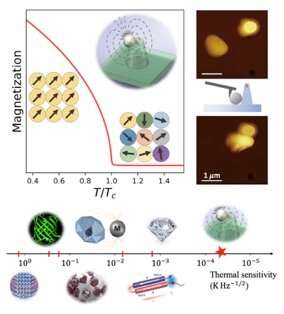Ultra-sensitive nanothermometer under ambient conditions

Nanoscale temperature measurement with high sensitivity is important to investigating many phenomena such as heat dissipation of nano-/micro-electronics, chemical reactions in nanoliter volume, thermoplasmonics of nanoparticles, and thermal processes in live systems. There have been various nanoscale thermometry schemes, including the SQUID-based nanothermometry, scanning thermal microscopy, and fluorescence thermometry based on rare-earth nanoparticles, dyes, or proteins. However, these techniques are limited by various factors, such as contact-related artifacts, fluorescence instability, low sensitivity, or the requirement of extreme working conditions.
The recent development of diamond-based thermometers provides a promising alternative. The spin resonance frequencies of nitrogen-vacancy (NV) centers in diamond shift with the environmental temperature change. Owing to the photostability of NV centers and the bio-compatibility and high thermal conductivity of the diamond material, diamond-based thermometers were applied to monitor the thermal processes in micro-electronics and live systems. However, the sensitivity of the diamond-based thermometers is limited by the relatively small temperature dependence of the NV spin resonance frequencies. Thus, there arises the idea of hybrid diamond thermometer, in which the temperature change in the environment is transduced to a magnetic signal to be detected by the NV center spins.
In new research published in the Beijing-based National Science Review, scientists at The Chinese University of Hong Kong in Hong Kong, China, and at the University of Stuttgart in Stuttgart, Germany constructed an ultra-sensitive hybrid nanothermometer. The hybrid nanothermometer was composed of a single NV center in a diamond nanopillar and a single copper-nickel alloy nanoparticle. The magnetic nanoparticle was placed close to the diamond nanopillar via nano-manipulation based-on atomic force microscopy. Near the Curie temperature of the magnetic nanoparticle, a small temperature change leads to a large magnetic field change due to the critical magnetization. This thermally sensitive magnetic signal was then measured by the NV center. The newly developed hybrid nanothermometer has a temperature sensitivity as high as a precision of 76 microkelvin in one second of measurement. This is by far the most sensitive nanothermometer working under ambient conditions.
Employing this hybrid sensor, the scientists monitored the temperature changes due to a laser heating process and environment temperature fluctuations. In addition, they measured the thermal dissipation near the sensor by additional heating with the current passing through a conducting wire. The ultra-sensitive hybrid nanothermometer is especially useful in measuring millikelvin temperature variation with high temporal resolution. The new sensor may facilitate the study of a broad range of thermal processes, such as nanoscale chemical reactions, nano-plasmonics, heat dissipation in nano-/micro-electronics, and thermal processes in single cells.
More information: Chu-Feng Liu et al, Ultra-sensitive hybrid diamond nanothermometer, National Science Review (2020). DOI: 10.1093/nsr/nwaa194
Provided by Science China Press



















